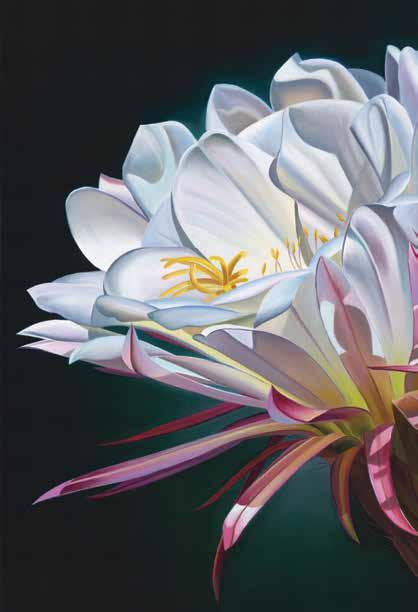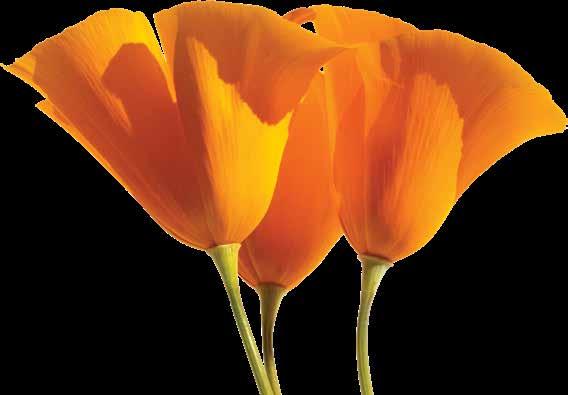
7 minute read
A Song of Nectar and Honey
The Waggle Dance: A Communicative Dance of one of the World’s most Reputable Pollinators
Text by Dara Heward Art by Clare Parkes
Advertisement
If there were a competition for the world's most reputable pollinator, honeybees would have a clear shot at first place. Most likely, you’ve seen hundreds to thousands of bees throughout your lifetime. It's possible that you even ran from one during a summer picnic when they relentlessly buzzed around your soda can. If you take a walk outside, even for a little while, you're likely to see at least one honeybee. Or, if you’re lucky, you’ll see many flying around an array of flowers. How do bees go about selecting which flowers to land on out of the millions that bloom every year?
This is a question that has led many researchers down a deep rabbit hole of scientific experiments that explore how bees might see and navigate the world. While discussing topics of her research, Dr Gloria DeGrandi-Hoffman, a Research Leader and Location Coordinator at the United States Department of Agriculture’s (USDA) Carl Hayden Bee Research Center in Tucson, Arizona, told me, “I’ve been studying honey bees for many, many years and still feel like there is more I don’t know than I do know about them. There are still so many fundamental questions.”
Evolution has been playing matchmaker between bees and flowers for millions of years, forming one of nature's closest relationships. The type of relationship that flowers and bees share is considered a symbiotic mutualism, in which each species benefits from one another. It’s a game of give and take; the flower produces nectar and pollen for the bee, and the bee helps the flower continue the next generation of seedlings by pollination. Pollen and nectar are great food sources for bees. Pollen is a source of protein, vitamins, minerals, and lipids. Nectar is a source of carbohydrates that the bee can also use to make honey to form their hives and feed their young.
Once flowers start blooming, the foraging begins. Yet, how do these tiny insects get around in such a large world with ample food choices?
Dr. DeGrandi-Hoffman describes what foraging working bees look for, “Primarily [bees] are looking for a flower source where the resources are abundant, consistent in providing resource, and accessible that they can reach down and get nectar easily. This means that they are accessible to honey bees and not other flowers that are more accessible to butterflies, moths, and birds. [The flowers] also need to provide a good concentration. The more concentrated the resource is, the more attractive it is. To give you an example, apple trees are really attractive to bees because they have these open dish shaped flowers that the bee can walk from flower to flower to get full loads of nectar and pollen on relatively small branches of trees and flowers. This is in contrast to something like a melon where there are male and female flowers, so you have to go to separate flowers to get pollen and they are spaced apart so that bees usually have to fly between them.”
Bees have evolved to be some of the most efficient pollinators known to man. They are so efficient, in fact, that humans use them as the choice pollinator in agriculture endeavors over and over again. This is because they are easily manageable in bee boxes, and can be moved around. What makes them even more efficient is the fact that they are social insects that work in colonies. The healthier a beehive, or colony, the more likely the bees can communicate food sources to each other. This communication results in a more productive pollination season and a stable population.
Although there are many ways that bees acquire efficiency, one example is that they adapt closely with multiple species of flowers over time, while also communicating systematically. Their intelligence as social insects have inspired and continue to inspire scientists. There are things we can learn from our little friends that can be applied to the human world.
Honey bee workers are able to send complex messages to each other using their great sense of smell and by chemically sending messages with pheromones. Dr. DeGrandi-Hoffman notes,
They communicate if a colony is under threat and needs to be in a defensive mode with alarm pheromones. They communicate if they don't have a queen. A lot of behaviors in a colony are chemically based.”
Bees also have a curious but remarkable dance they use to communicate with each other. Like an instinctual reflex, honey bee foragers use a balletic figure eight pattern full of vibrations and motion to communicate to each other through a dance called “The Waggle Dance.” According to Dr. DeGrandi-Hoffman, this dance is a behavior, “that bees have formed to communicate distance and direction of food sources to their nest mates.” This dance is communicating the source of pollen, nectar, propolis (tree resin) , new hive sites, or water.
Upon opening a beehive box, you can pick out a dancing bee out of the mosaic of the other honeybees quite easily. She, the foraging honey bee, fans her wings rapidly, and dances in a figure eight motion. Her wings fan so fast, the translucent structure of them almost disappears. She follows the same directional line back and forth conveying her message to her hive mates, "this is the direction of the flowers I found, spread the message." She keeps the same constant angle while turning one direction, circling around, and then repeating this motion in the opposite direction. Her movements create a bilaterally symmetrical mirror-image, left and right halves if divided sagittally. Gravity creates her up and down directional constants, and the sun creates her solar compass. Bees know the sun’s position in the sky at all times.
Other bees watch as this dance is performed, angling their antennae in the direction of the performer. One or two observers will join the dancer in the first circuit of the dance. During the return run of the dance, the follower(s) will touch antennae with the dancer. The corresponding dancers will follow her for a few circuits, then be guided to the resource. Once resources are gathered, they then go back to the colony where they will verify the information as a reliable source. As more bees verify the information, the resources are then utilized for the colonies benefit.
According to Dr. DeGrandi-Hoffman, “A colony is composed of a laying queen, larvae, pupae (sealed brood), and adult bees of all ages. Together, that's a colony of bees. Bees thermoregulate their colonies, so their development times are verystable. As a worker she will be an egg for 3 days, larvae for 6 days, and in 12 days she will go through pupation and emerge. It’s a 21-day life-cycle to go from egg to an emerged adult bee.”
“The first few days of her life she eats a lot of pollen and activates her glands in her head, called hypopharyngeal glands. She starts to produce a milky white liquid that then she feeds to the larvae and the queen. That's what an adult worker will do for about the first week of her life.”
“Then, she will stop eating pollen and start doing things around the nest like cleaning and structure building. She will receive loads of nectar coming from bees that are foraging in the field. She will also help get those loads of nectar into the cells in the colony, help secrete wax to make cells if they are running out of room, clean up debris, and defend the colony.”
“When the bee is around about 3 weeks old, she will become a forager. After a few weeks as a forager, she will usually die somewhere out in the field. In the summertime, the average lifespan is 5-6 weeks. If it's winter time and its cold, however, they could live throughout the winter in a cluster for several months.”
It's a complex, yet simple life for the working honeybee. You live for the colony first as a nurse bee, then as a home bee. Then, you finish off your life as a forager, living off of food from flowers, providing food by navigation of the sun, and working together for a common goal of survival. So, next time you see a bee buzzing around in the garden, imagine how their world looks and think about how much nature remains invisible unless you see it through the right pair of eyes. Try this experiment out: take an ultraviolet light and shine it at a flower. Can you see the nectar pathways? Bees see in ultraviolet light! This is another way bees are able to pick the best flowers with the most nectar. Want to attract more bees in your garden? According to Dr.
DeGrandi-Hoffman, “Plant flowers! Reduce the use of pesticides and household chemicals. Those two things could go a long way.” Also, look for flower mixes that bees love! Try a nuturing mix that includes Desert Bluebells, Desert Lupine, Desert Marigold, Golden Dyssodia, Goodings Verbena, Mexican Gold Poppy, Rocky Mountain Bee Plant, Sand Verbena, Yellow Mexican Hat, Yellow Bee Plant, and White Evening Primrose.






